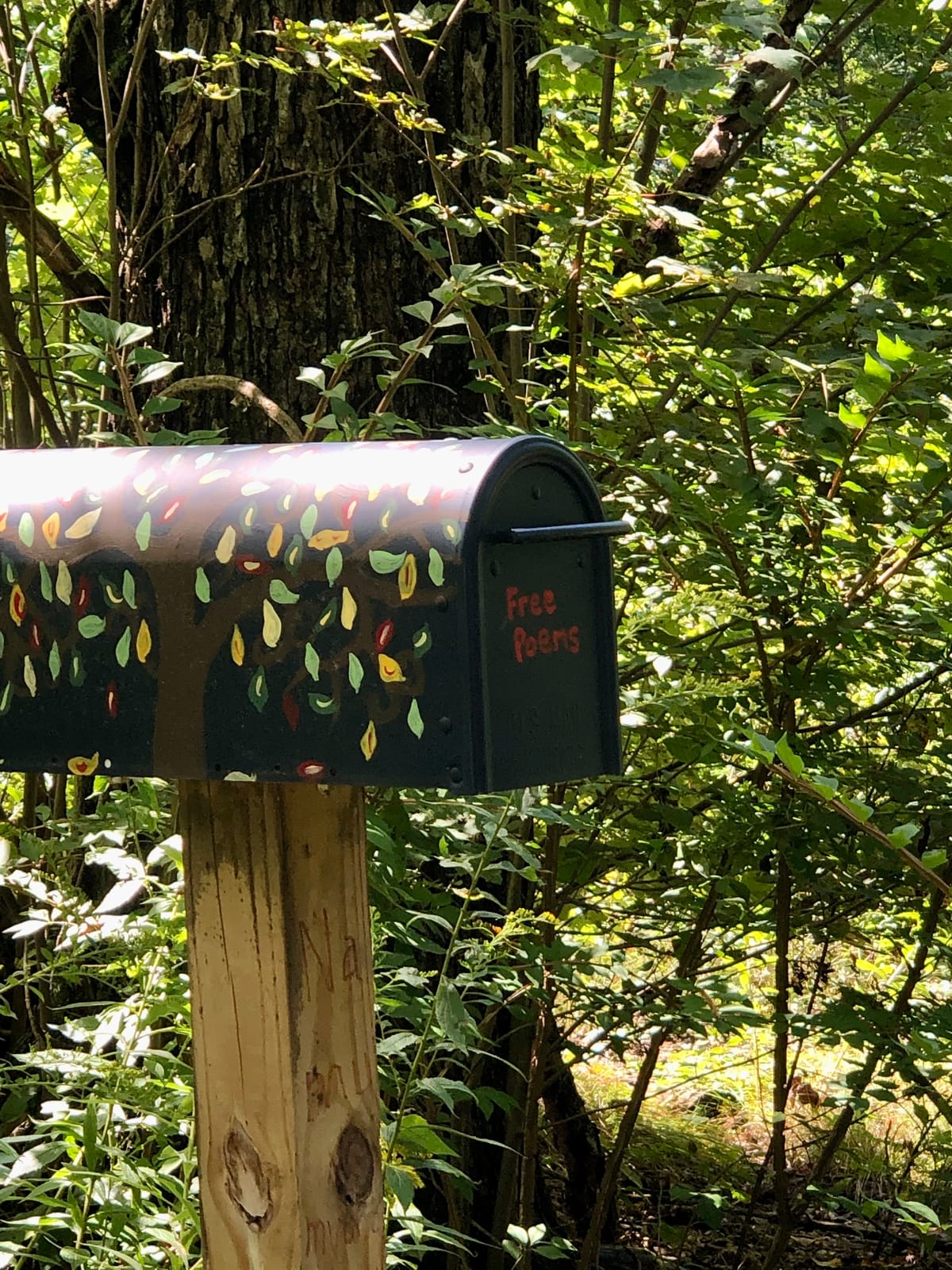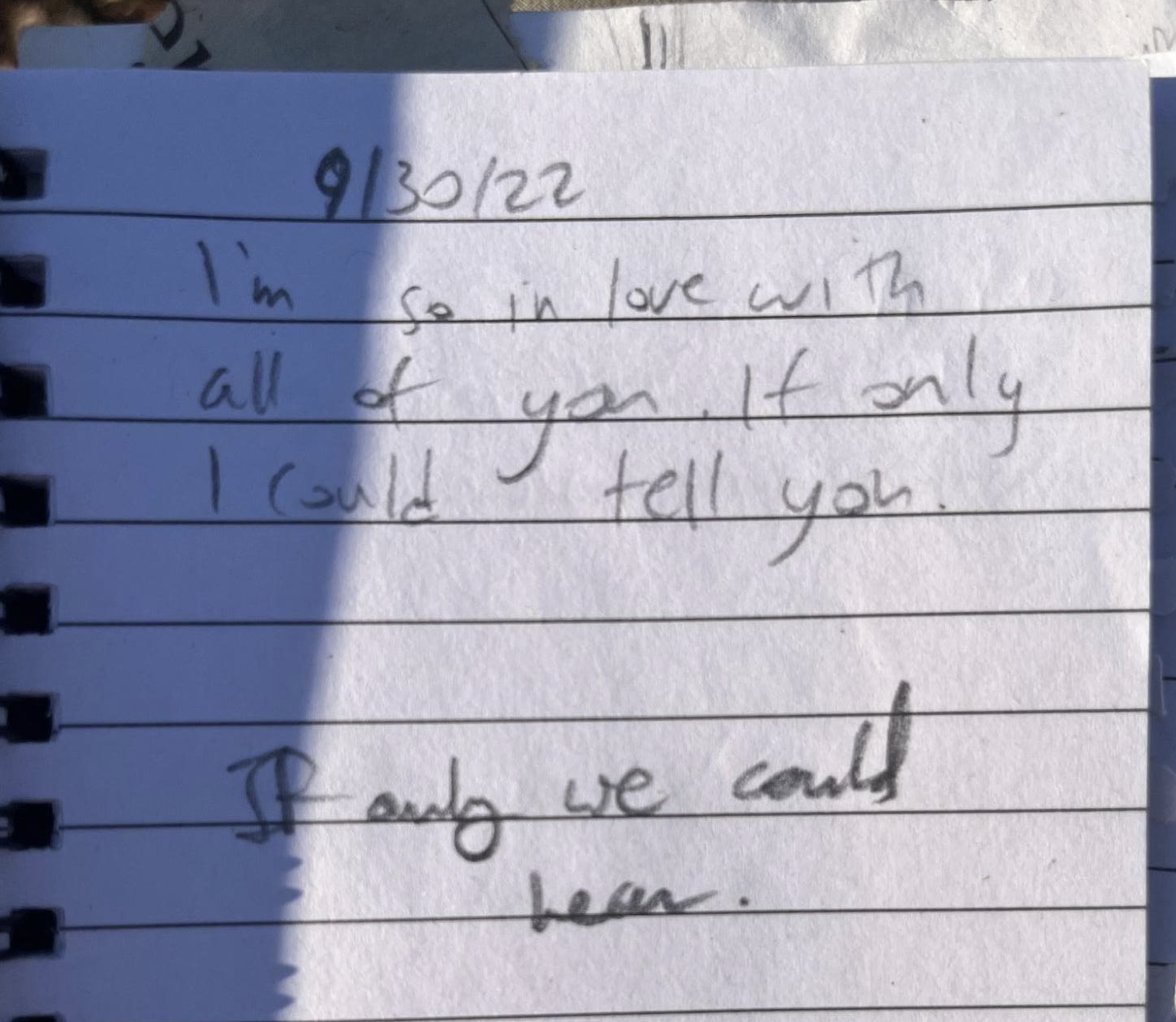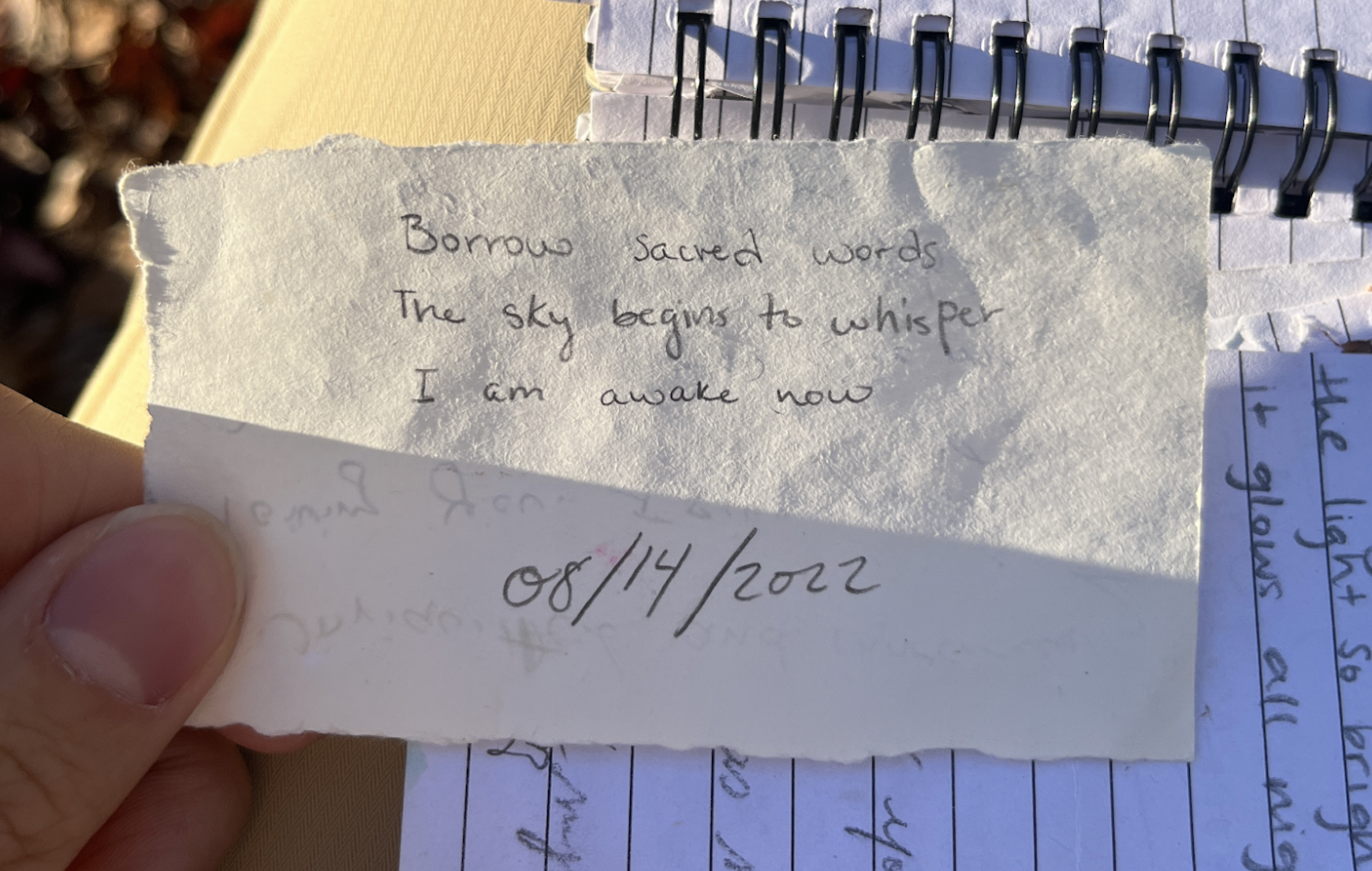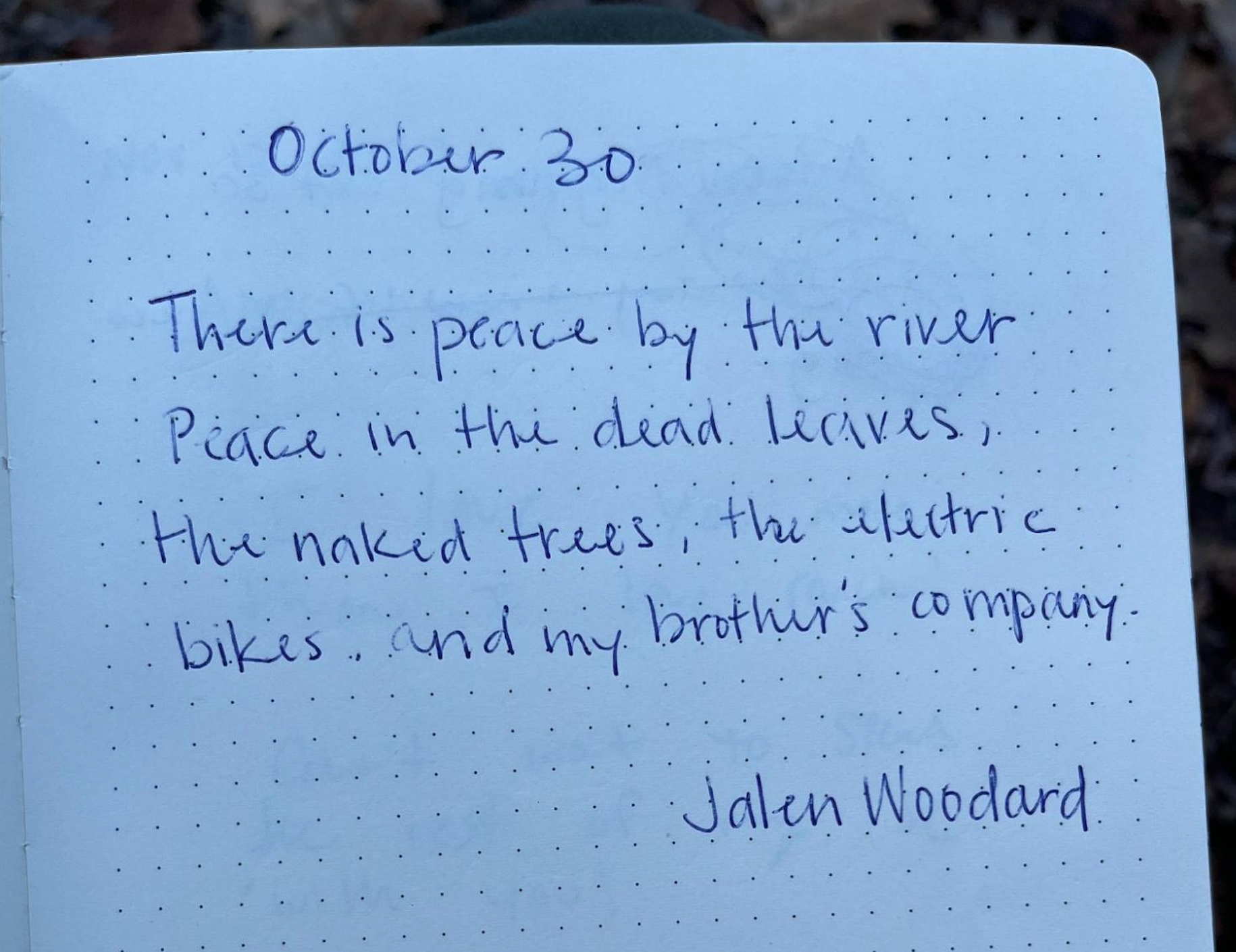Whispers in the Woods: An Investigation of Amherst’s Poetry Boxes
Poetry mailboxes populate Amherst’s hiking trails, thriving in secrecy. Humphrey Chen ’26 attempts to understand these fixtures of the college and their cloudy origins.

“Can we stop, Listen?
Slow down. It’s okay.
Just … Listen”
— Anonymous
Hidden in the foliage, among the nooks and crannies in Amherst’s Wildlife Sanctuary, sit musty, unassuming mailboxes. Beneath their splintering surfaces, you will find narratives, diary entries, love letters, illustrations, raunchy NSFW jokes, and so much more. Amongst the 94 miles of natural terrain, you will only find two such boxes: one on the Emily Dickinson trail and another near Book and Plow Farm. These poetry boxes are Amherst’s well-kept secret.
The boxes persist at the intersection of nature, literature, and discovery, yet many people don’t even know they exist. I’m surprised that these posts don’t have a gaggle of English majors constantly circling around them in prayer, kneeling before a shrine and blood sacrifice. These fixtures deserve a spotlight … and maybe that blood sacrifice. So, follow my attempts at uncovering the origin of these elusive installations.
Phase 1: Google
From my initial Google search of “Amherst poetry boxes,” I found an article about the box on Emily Dickinson trail. Amherst citizen and garden society member, Roxy Schneider, dedicated the Dickinson box to her late husband, Charlie Parham, the article explained. An avid poetry reader, Parham taught English and managed a literature program in South Hadley for gifted children. The box serves as a monument for Charlie Parham’s legacy, and a recognition of Schneider’s grief. The leather-bound notebook within the box carries countless entries, replies, and interactions, all attesting to Parham’s legacy. It’s a memorial befitting an educator.

A straightforward and sweet history for post number one. Unfortunately, the investigation only gets messier from here.
Phase 2: Emails. God, so many emails.
I directed my first wave of emails to the Outing Club, Poetry Club, and Maida Ives, manager of farm education and operations at Book and Plow Farm. Ives recounted how “through the years, [she] read a few and dropped a few poems in the one closest to B&P.” From Ives, I also learned about Mark Uchneat, assistant supervisor of grounds. Uchneat responded kindly, but didn’t know much either. Another dead end. Beaten, broken, and bedraggled, my editors gave me new leads to contact: Lecturer in English and Director of the Creative Writing Program Kirun Kapur and Mike Kelly, head of archives & special collections. Emails sent. Replies received: “unfortunately I don’t have any insight …” “I’m so sorry I don’t know much about …” “... why would I care …”
Things were looking so bleak.
One afternoon, I messaged Nicola Courtright, the William McCall Vickery 1957 professor of the history of art. Given the previous failures, I didn’t expect much. However, after a short exchange she agreed to an interview. The light in my abyss. A glorious rain amid a harsh drought. Live, love, laugh Courtright.
Phase 3: A Chat With Professor Courtright
Q: How do you feel about the poetry boxes sprinkled around our hiking trails?
A: Whoever came up with this has the fabulous idea of not just having it be a place where you, a passive person, would pick up a poem and read it, but where you could write your own poem … The idea is that you experience the feelings that you’re having with a poem in nature. To have it be an exchange is so Amherst.
Q: How did you first find these boxes?
A: It was a total accident. When we went on our hike to look at the bird sanctuary area, we stumbled upon this poetry box … It was like this great discovery, like, “Oh my god, here’s this poetry box let’s go read from it!” Some student picks a poem and reads it aloud for the rest. Then we continue on our way. It’s hard to read a poem. That is to say, you really have to be calm, you have to be intentional, and you have to sit down and really focus on the poem.

Q: How do these boxes reflect Amherst’s relationship with nature?
A: Amherst is a place that’s all about walking in nature. The college even bought many, many acres of land so that the view of Amherst, being nestled in the hills, wouldn’t be disturbed by settlements. The whole idea of walking in nature and associating walking with poetry is long standing … going back to classical antiquity and the idea of nature associated with beauty, nature associated with feelings, nature associated with beautiful poetic expression — those things are way [integrated] into the classical tradition that I’ve [experienced]. So, Amherst really cares about being a place that is in nature. This goes back to an old idea that gentlemen learned from being out of urban centers and out in nature, and that you learn by discovery and seemingly wandering — not towards a goal or something — but [that’s how] you begin to have ideas. That’s the sort of environment that Amherst College wanted to cultivate after a certain point.

Phase 4: Eureka-ish
When students encounter a poetry box, it feels like an intimate surprise. The aged wood and chipping paint invite vulnerability because there is safety in nature and antiquity. Jalen Woodard ’23 reflected how the box “gave [him] the chance to be creative, to express what [he] was feeling in the moment.” When I asked about his thoughts on the boxes’ obscurity, Woodard replied, “I wondered … who was in charge of refilling the boxes with fresh journals? Who would read my poem? I loved the idea of someone stumbling on my poem and sharing the same appreciation for nature as I had. The same peace I had experienced sitting by the river.”

Dissecting the history of this mailbox invalidates the wonders of Woodard and many others. Courtright can attest to the beauty of poetry, nature, and the unknown. To stifle the true potential of this fixture by clawing at its origins is antithetical to the academic and spiritual purpose that nature holds at Amherst. Especially when interacting with poetry, an intimate medium, there is solace in mystery. Knowing is confining, whereas uncertainty is liberating. Authors and visitors of the boxes can ascribe their own histories to the boxes, allowing this meaning to fulfill their needs at the moment.
If I were to hunt down the keeper of this post and unveil its every intricacy, would it really be the same?
Thus, the mystery of Amherst poetry mailboxes remains alive: constructed by a faculty member? Uprooted from the lawn of an unassuming Amherst denizen? Grown from a novel, planted into the earth and watered with the tears of English theses students? We might never know.
How poetic.
Correction, Dec. 4, 2022: A previous version of this article misstated that Mark Uchneat had not responded to the writer’s inquiry. He had, in fact, responded.





Comments ()